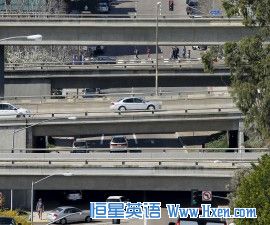英语访谈节目:美国基础设施收到差评
HARI SREENIVASAN, PBS NEWSHOUR WEEKENDANCHOR: The nation's infrastructure received an overall grade of "D- plus" in a report card published this week by the American Society of Civil Engineers, the same grade the group issued in 2013. Among the 16 categories graded: bridges received a "C-plus"; roads, dams and airports, a "D"; while mass transit came in with a "D-minus."
The group's senior managing director, Casey Dinges, joins me now from Washington to explain these very low grades.
Mr. Dinges, these are not grades that we would want to see on any child's report card. Yet, I guess we tolerate them at such crucial things as the roads and bridges we drive on and the water that we drink.
CASEY DINGES, SENIOR MANAGING DIRECTOR, AMERICAN SOCIETY OF CIVIL ENGINEERS: I think the way the issue may play out is that the degradation is maybe so imperceptible to the public users, the traveling public you know, the water main break, even though it happens every 2 1/2 minutes in the United States, people my say, "Well, it's just not happening in my neighborhood, so I'm not thinking about it." Traffic congestion is a huge issue in major metropolitan areas. Pavement issues you'll find in regions all across the country affect people, but maybe not enough to make it a top-of-mind issue.
So, at this point, we are somewhat encouraged to see presidential leadership being exerted on the infrastructure issue. But funding is the key thing. That would be the heavy lift for the Congress.

SREENIVASAN: The trillion-dollar plan that President Trump has alluded to and perhaps will propose in writing is not enough to cover the kinds of upgrades that you're saying our infrastructure needs today.
DINGES: It's not. You know, the gap we identify is $2 trillion over 10 years. That's how we have the $200 billion-a-year number. But if $1 trillion were to come forth from the federal government in a number of years in orderly fashion, that's OK.
But you have state and local government have a huge role to play and then also the private sector. You've probably heard there's a lively discussion going on about how we can use more public-private partnerships —
SREENIVASAN: Sure.
DINGES: — in some of these infrastructure categories.
SREENIVASAN: How do you change the thinking about this? Because it's not very sexy to fund a new water main or a waste water system that's crucial. And yet, we start to think about this in very specific terms when there's a dam that's about to break or when there's a bridge that just collapsed.
DINGES: It's easy to take for granted your water supply, your bridges, your tunnels, until they're suddenly not there. Certainly in this region, we've seen a number of — I should point out transit was the lowest graded, "D-minus," across the country, certainly here in the Washington area, the capital of the United States, just a 40-year-old system that's showing signs of complete breakdown after decades of under-investment and ignored maintenance.
So, it's a wake-up call for the country. People need to realize, this issue is already costing each family $9 a day. And what our economic studies suggest is that for an investment of just $3 per day per family, you could eliminate that drag on the economy and if we don't we're putting at risk 2.5 million jobs by the year 2025, and nearly $4 trillion in U.S. GDP. That's the equivalent of Germany's GDP.
SREENIVASAN: All right. Casey Dinges from the American Society of Civil Engineers — thanks so much.
DINGES: Good to be with you.




 手机网站
手机网站